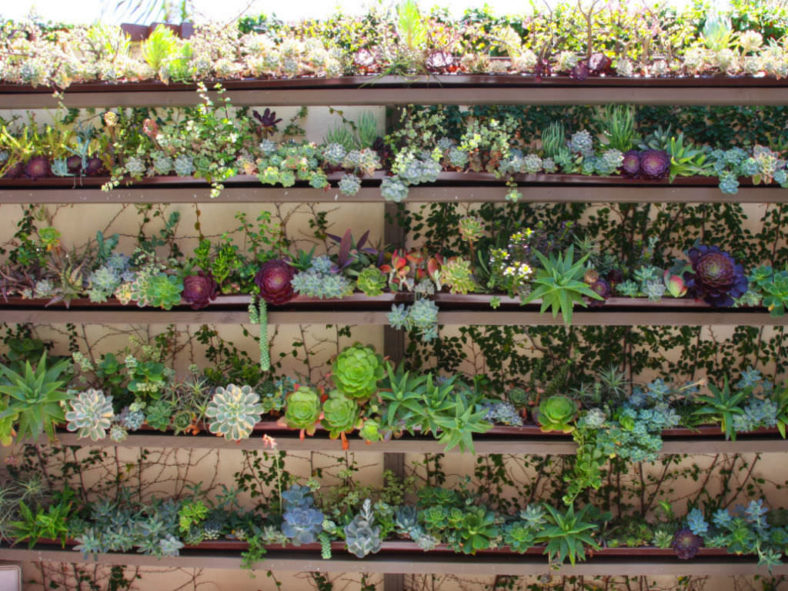We have explored specific care methods for various types of succulents in the Ultimate Guide to Succulents: Types of Succulents. Some care instructions depend on your zone or whether the plant is outdoors or in a container. General guidelines for succulent care are below.
How Often to Water
Most succulents don't need a lot of water. The general rule is to let the top half of the soil dry out before you water it again. In the summer, outdoor succulents typically require watering once a week. Water container plants once or twice a week.
You'll usually reduce irrigation in lower temperatures, even for indoor houseplants. However, different varieties of succulents require different amounts of water. Check with a local nursery or the company from which you bought the plant for specific watering instructions.
Propagating
Succulents are best grown from offsets. If your plant sends out "pups," you can remove those smaller "babies" and replant them.
You can also propagate the plants from leaves. First, snap off a few of the lower leaves from the plant. To do this, hold the leaf close to the base. Wiggle and twist it until it separates from the stem. Choose healthy leaves, and propagate a few at a time. Not all of them will propagate. Leave the leaves in a cool, dry place for up to a week. The cut end should develop a hard callous that resembles a scab. Once that happens, you can begin to sprout new roots. Fill a shallow container with soil designed for potted succulents. Lay the leaves horizontally on top of the soil.
Leave the container in indirect sunlight. Spray the top of the soil with water every day. It should be damp but not wet. Don't mist the soil if you live in a humid climate. In about a month, you'll see roots growing from the cut end of the leaf toward the soil. You can lightly cover the roots with soil to prevent them from drying out. A miniature version of the plant will grow upward from the cut end of the leaf. When that small plant develops its own root system and the original leaf begins to deteriorate noticeably, remove the leaf from the new plant in the same manner that you removed it from the mother plant. Be careful not to disturb the new roots. Then, replant the new succulent in its own pot. Use a small pot at first, and use cactus or succulent soil.
Soil
Succulents grow best in soil that drains well. Some types prefer nutrient-dense soil, but most do well if the soil isn't too moist. Most garden stores sell soil that's designed for cacti and succulents. If you're growing succulents in containers, mix equal parts of sand, potting soil, and perlite. Outdoor succulents should be fed with a low-balanced fertilizer (10-10-10) in spring and late summer. Use about half the recommended ratio of fertilizer to water. Only fertilize when the soil is dry.
Sunlight
Nearly all succulents thrive in ample light. Your plants should get approximately six hours of direct sunlight every day. Depending on your planting zone and the type of plant, you may need to shade your succulents during the hottest part of the day.
Indoor succulents should be placed near a window. However, they shouldn't get burned by direct sunlight. Succulents are relatively resilient when it comes to their sunlight needs. Less light may cause the colors to become dull. The plants may not bloom without sufficient UV light. However, they will survive in many lighting conditions.
Where to Buy Succulents
Once you start looking for succulents, you'll notice they're sold in many places. A local supplier may be able to provide you with succulents that are better for your area. Succulent plant groups can provide cuttings, seeds, or mature plants. Local botanical gardens may also sell succulents.
Many garden shops carry succulents, from large chain stores to smaller local nurseries. However, finding rare or unusual species here may be difficult. Succulents sold in garden shops are often already potted.
Some of the most beautiful, unique, and vibrant succulents are difficult to find locally. Thank goodness for the internet. Many online vendors offer direct shipping of these plants to you. You can choose the specific variety that you purchase. You can often get a discount if you buy large sets of mixed varieties. Buying succulents in bulk online may be preferable if you're trying to fill a vertical garden or a large space. The plants are often sold in plugs that can be replanted at the final destination.
Succulents are not expensive. You can get plants for anywhere from $2 to $10 on average. The size and rarity of the plant often determine the price. You can get them even more affordably by trading with other growers, propagating the leaves, or replanting offsets.
Succulents have become increasingly popular due to their ease of maintenance and unique style. There is a wide range of succulents, so you should have no trouble finding one that matches your garden or style.
Source: everythingbackyard.net
Links
- Read also: Ultimate Guide to Succulents: Types of Succulents
- Succupedia: Browse succulents by Scientific Name, Common Name, Genus, Family, USDA Hardiness Zone, Origin, or cacti by Genus
